Dispersion Behavior of High-k Perovskite Nanosheets for Ink Formulation and Device Printing
IF 7
2区 材料科学
Q2 CHEMISTRY, PHYSICAL
引用次数: 0
Abstract
Solution-processable high-k perovskite nanosheets show considerable potential for applications in printed electronics due to their unique structural properties and exceptional physical characteristics. However, their dispersibility and compatibility in various organic solvents remain insufficiently understood, with a lack of systematic investigation, which restricts their broader application potential. In this study, the dispersion behavior of high-k perovskite nanosheets, specifically Ca2Nb3O10 (CNO) and Ca2NaNb4O13 (CNNO), was examined in 20 different organic solvents. By correlating the physicochemical properties of these solvents, including surface tension, dielectric constant, and empirical solvent parameters, with Hildebrand and Hansen solubility models, we identified the underlying solvent–nanosheet interaction mechanisms responsible for dispersion stability. Polar protic solvents, such as water and methanol (MeOH), as well as polar aprotic solvents, like dimethyl sulfoxide (DMSO), acetonitrile (ACN), N,N-dimethylformamide (DMF), propylene carbonate (PC), and N-methyl-2-pyrrolidone (NMP), facilitate uniform and stable nanosheet dispersions. These solvents promote dispersion stability through strong dipole–dipole interactions and moderate surface tension matching. Based on these findings, we developed a series of organic solvent-based inks incorporating high-k perovskite nanosheets, demonstrating excellent printing adaptability for electrical device fabrication, and achieving stable device performance. This work provides a comprehensive library of organic solvents that effectively disperse high-k perovskite nanosheets, thereby broadening their potential applications in printed electronic devices.

高钾钙钛矿纳米片在油墨配方和器件印刷中的分散行为
溶液可加工的高钾钙钛矿纳米片由于其独特的结构特性和卓越的物理特性,在印刷电子领域显示出相当大的应用潜力。然而,它们在各种有机溶剂中的分散性和相容性尚不清楚,缺乏系统的研究,限制了它们更广泛的应用潜力。在本研究中,研究了高钾钙钛矿纳米片,特别是Ca2Nb3O10 (CNO)和Ca2NaNb4O13 (CNNO)在20种不同有机溶剂中的分散行为。通过将这些溶剂的物理化学性质(包括表面张力、介电常数和经验溶剂参数)与Hildebrand和Hansen溶解度模型相关联,我们确定了影响分散稳定性的潜在溶剂-纳米片相互作用机制。极性质子溶剂,如水和甲醇(MeOH),以及极性非质子溶剂,如二甲基亚砜(DMSO),乙腈(ACN), N,N-二甲基甲酰胺(DMF),碳酸丙烯酯(PC)和N-甲基-2-吡啶酮(NMP),促进了均匀稳定的纳米片分散。这些溶剂通过强的偶极-偶极相互作用和适度的表面张力匹配来促进分散稳定性。基于这些发现,我们开发了一系列含有高钾钙钛矿纳米片的有机溶剂型油墨,在电子器件制造中表现出出色的印刷适应性,并实现了稳定的器件性能。这项工作提供了一个全面的有机溶剂库,可以有效地分散高钾钙钛矿纳米片,从而扩大其在印刷电子器件中的潜在应用。
本文章由计算机程序翻译,如有差异,请以英文原文为准。
求助全文
约1分钟内获得全文
求助全文
来源期刊

Chemistry of Materials
工程技术-材料科学:综合
CiteScore
14.10
自引率
5.80%
发文量
929
审稿时长
1.5 months
期刊介绍:
The journal Chemistry of Materials focuses on publishing original research at the intersection of materials science and chemistry. The studies published in the journal involve chemistry as a prominent component and explore topics such as the design, synthesis, characterization, processing, understanding, and application of functional or potentially functional materials. The journal covers various areas of interest, including inorganic and organic solid-state chemistry, nanomaterials, biomaterials, thin films and polymers, and composite/hybrid materials. The journal particularly seeks papers that highlight the creation or development of innovative materials with novel optical, electrical, magnetic, catalytic, or mechanical properties. It is essential that manuscripts on these topics have a primary focus on the chemistry of materials and represent a significant advancement compared to prior research. Before external reviews are sought, submitted manuscripts undergo a review process by a minimum of two editors to ensure their appropriateness for the journal and the presence of sufficient evidence of a significant advance that will be of broad interest to the materials chemistry community.
 求助内容:
求助内容: 应助结果提醒方式:
应助结果提醒方式:


